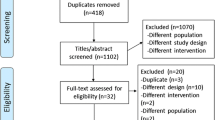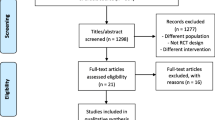Abstract
Background
Zinc is an essential trace element that has been implicated in numerous biological functions, including immunity, energy metabolism and antioxidative processes. Recent evaluations of the literature have provided evidence of significant acute changes in zinc metabolism following a bout of aerobic exercise.
Objective
The aim of this study was to determine the zinc status of trained athletes compared with control populations, as described in cross-sectional studies.
Design
We conducted a systematic literature search of the PubMed, Scopus, SPORTDiscus and Cochrane Library electronic databases from inception to 28 January 2016 to identify cross-sectional studies that determined the zinc status of athletes compared with a control population. Meta-analysis of the differences in serum zinc concentration and dietary zinc intake between groups were conducted.
Results
Twelve studies were included in the systematic review. Of the included studies, nine and eight studies provided sufficient data for the meta-analysis of serum zinc concentration and dietary zinc intake, respectively. Serum zinc concentration was significantly lower in athletes [− 0.93 μmol/L, 95% confidence interval (CI) − 1.62 to − 0.23] despite significantly higher dietary zinc intake compared with the control population (2.57 mg/day, 95% CI 0.97–4.16). Data on erythrocyte and urinary zinc from the included studies were insufficient for meta-analysis.
Conclusions
Despite higher total dietary zinc intake, athletes generally have lower serum zinc concentration, which suggests that athletes have higher requirement of zinc than those who are physically inactive. Further investigations of zinc metabolism during exercise and dietary zinc requirement in active populations are needed to establish evidence-based recommendations.




Similar content being viewed by others
References
Samman S. Zinc. Nutr Diet. 2007;64:S131–4.
Chu A, Foster M, Samman S. Determinants of zinc transport in humans: zinc status, exercise, inflammation and chronic diseases. In: Ostojic S, editor. Human health and nutrition: new research. New York: Nova Science; 2015. p. 17–48.
Foster M, Samman S. Zinc and redox signaling: perturbations associated with cardiovascular disease and diabetes mellitus. Antioxid Redox Signal. 2010;13:1549–73.
Capdor J, Foster M, Petocz P, Samman S. Zinc and glycemic control: a meta-analysis of randomised placebo controlled supplementation trials in humans. J Trace Elem Med Biol. 2013;27:137–42.
Coyle EF. Physical activity as a metabolic stressor. Am J Clin Nutr. 2000;72(Suppl):512S–20S.
Gleeson M, Williams C. Intense exercise training and immune function. Nestle Nutr Inst Workshop Ser. 2013;76:39–50.
Simpson RJ, Kunz H, Agha N, Graff R. Exercise and the regulation of immune functions. Prog Mol Biol Transl Sci. 2015;135:355–80.
Egan B, Zierath JR. Exercise metabolism and the molecular regulation of skeletal muscle adaptation. Cell Metab. 2013;17:162–84.
Margolis LM, Pasiakos SM. Optimizing intramuscular adaptations to aerobic exercise: effects of carbohydrate restriction and protein supplementation on mitochondrial biogenesis. Adv Nutr. 2013;4:657–64.
Miranda ER, Dey CS. Effect of chromium and zinc on insulin signaling in skeletal muscle cells. Biol Trace Elem Res. 2004;101:19–36.
Foster M, Samman S. Zinc and regulation of inflammatory cytokines: implications for cardiometabolic disease. Nutrients. 2012;4:676–94.
König D, Weinstock C, Keul J. Zinc, iron, and magnesium status in athletes–influence on the regulation of exercise-induced stress and immune function. Exerc Immunol Rev. 1998;4:2–21.
Powers S, Jackson M. Exercise-induced oxidative stress: cellular mechanisms and impact on muscle force production. Physiol Rev. 2008;88:1243–76.
Chu A, Petocz P, Samman S. Immediate effects of aerobic exercise on plasma/serum zinc levels: a meta-analysis. Med Sci Sports Exerc. 2016;48:726–33.
Chu A, Petocz P, Samman S. Plasma/serum zinc status during aerobic exercise recovery: asystematic review and meta-analysis. Sports Med. 2017;47:127–34.
DeRuisseau KC, Cheuvront SN, Hyames EM, Sharp RG. Sweat iron and zinc losses during prolonged exercise. Int J Sport Nutr. 2002;12:428–37.
Liberati A, Altman DG, Tetzlaff J, Mulrow C, Gøtzsche PC, Ioannidis JPA, et al. The PRISMA statement for reporting systematic reviews and meta-analyses of studies that evaluate health care interventions: explanation and elaboration. PLoS Med. 2009;6:e1000100.
Veritas Health Innovation. Covidence systematic review software. Melbourne, VIC. http://www.covidence.com.
Guyatt GH, Oxman AD, Vist G, Kunz R, Brozek J, Alonso-Coello P, et al. GRADE guidelines: 4. Rating the quality of evidence: study limitations (risk of bias). J Clin Epidemiol. 2011;64:407–15.
The Cochrane Collaboration. Review manager (RevMan). Copenhagen: The Nordic Cochrane Centre; 2014.
Arikan S, Akkus H, Halifeoglu I, Baltaci AK, Arikan S, Akkus H, et al. Comparison of plasma leptin and zinc levels in elite athletes and sedentary people. Cell Biochem Funct. 2008;26:655–8.
Bazzarre T, Marquart L, Wu S, Izurieta M. Zinc status among low-fat and moderate-fat male triathletes and controls. J Trace Elem Exp Med. 1989;2:277–83.
Crespo R, Relea P, Lozano D, Macarro-Sanchez M, Usabuaga J, Villa L, et al. Biochemical markers of nutrition in elite-marathon runners. J Sport Med Phys Fit. 1995;35:268–72.
Deuster PA, Day BA, Singh A, Douglass L, Moser-Veillon PB. Zinc status of highly trained women runners and untrained women. Am J Clin Nutr. 1989;49:1295–301.
Fogelholm M, Laakso J, Lehto J, Ruokonen I. Dietary intake and indicators of magnesium and zinc status in male athletes. Nutr Res. 1991;11:1111–8.
Fogelholm GM, Himberg JJ, Alopaeus K, Gref CG, Laakso JT, Lehto JJ, et al. Dietary and biochemical indices of nutritional status in male athletes and controls. J Am Coll Nutr. 1992;11:181–91.
Lloyd T, Dolence LA, Bartholomew MJ. Nutritional characteristics of recreational women runners. Nutr Res. 1992;12:359–66.
Lukaski HC, Bolonchuk WW, Klevay LM, Milne DB, Sandstead HH. Maximal oxygen consumption as related to magnesium, copper, and zinc nutriture. Am J Clin Nutr. 1983;37:407–15.
Nuviala RJ, Lapieza MG, Bernal E. Magnesium, zinc, and copper status in women involved in different sports. Int J Sport Nutr. 1999;9:295–309.
Rodríguez Tuya I, Pinilla Gil E, Maynar Mariño M, García-Moncó Carra RM, Sánchez Misiego A. Evaluation of the influence of physical activity on the plasma concentrations of several trace metals. Eur J Appl Physiol Occup Physiol. 1996;73:299–303.
Singh A, Deuster P, Moser P. Zinc and copper status of women by physical activity and menstrual status. J Sport Med Phys Fit. 1990;30:29–36.
Teixeira V, Valente H, Casal S, Marques F, Moreira P. Antioxidant status, oxidative stress, and damage in elite trained kayakers and canoeists and sedentary controls. Int J Sport Nutr Exerc Metab. 2009;19:443–56.
Montero D, Lundby C. Red cell volume response to exercise training: association with aging. Scand J Med Sci Sports. 2016;27:674–83.
Hausswirth C, Le Meur Y. Physiological and nutritional aspects of post-exercise recovery specific recommendations for female athletes. Sports Med. 2011;41:861–82.
Pingitore A, Lima GPP, Mastorci F, Quinones A, Iervasi G, Vassalle C. Exercise and oxidative stress: potential effects of antioxidant dietary strategies in sports. Nutrition. 2015;31:916–22.
Paulsen G, Mikkelsen UR, Raastad T, Peake JM. Leucocytes, cytokines and satellite cells: what role do they play in muscle damage and regeneration following eccentric exercise? Exerc Immunol Rev. 2012;18:42–97.
Volpe SL, Lowe NM, Woodhouse LR, King JC. Effect of maximal exercise on the short-term kinetics of zinc metabolism in sedentary men. Br J Sports Med. 2007;41:156–61.
Petersen AMW, Pedersen BK. The anti-inflammatory effect of exercise. J Appl Physiol. 2005;98:1154–62.
Lukaski HC. Magnesium, zinc, and chromium nutriture and physical activity. Am J Clin Nutr. 2000;72:585S–93S.
Liuzzi JP, Lichten LA, Rivera S, Blanchard RK, Aydemir TB, Knutson MD, et al. Interleukin-6 regulates the zinc transporter Zip14 in liver and contributes to the hypozincemia of the acute-phase response. Proc Natl Acad Sci USA. 2005;102:6843–8.
Koury J, de Oliveira A, Portella ES, de Oliveira CF, Lopes GC, Donangelo CM. Zinc and copper biochemical indices of antioxidant status in elite athletes of different modalities. Int J Sport Nutr Exerc Metab. 2004;14:358–72.
Chu A, Samman S. Zinc homeostasis in exercise: implications for physical performance. Vitam Miner. 2014;3:40–2.
Gonzalez JT, Fuchs CJ, Betts JA, van Loon LJC. Glucose plus fructose ingestion for post-exercise recovery-greater than the sum of its parts? Nutrients. 2017;9:344.
Sandström B. Bioavailability of zinc. Eur J Clin Nutr. 1997;51:S17–9.
National Health and Medical Research Council. Nutrient reference values for Australia and New Zealand including recommended dietary intakes. Canberra: National Health and Medical Research Council; 2006.
Lowe NM, Dykes FC, Skinner A-L, Patel S, Warthon-Medina M, Decsi T, et al. EURRECA-estimating zinc requirements for deriving dietary reference values. Crit Rev Food Sci Nutr. 2013;53:1110–23.
Hess S, Peerson J, King J, Brown K. Use of serum zinc concentration as an indicator of population zinc status. Food Nutr Bull. 2007;28:S403–29.
Lukaski HC. Low dietary zinc decreases erythrocyte carbonic anhydrase activities and impairs cardiorespiratory function in men during exercise. Am J Clin Nutr. 2005;81:1045–51.
Author information
Authors and Affiliations
Contributions
Anna Chu and Samir Samman designed the research; Anna Chu, Cushla Holdaway, Trishala Varma and Samir Samman conducted the research; Anna Chu, Peter Petocz and Samir Samman analysed the data; and Anna Chu, Cushla Holdaway, Peter Petocz and Samir Samman wrote the paper. Samir Samman had primary responsibility for the final content. All authors read and approved the final version submitted for publication.
Corresponding author
Ethics declarations
Funding
No sources of funding were used to assist in the preparation of this article.
Conflict of interest
Anna Chu, Cushla Holdaway, Trishala Varma, Peter Petocz and Samir Samman declare that they have no conflicts of interest relevant to the content of this review.
Electronic supplementary material
Below is the link to the electronic supplementary material.
Rights and permissions
About this article
Cite this article
Chu, A., Holdaway, C., Varma, T. et al. Lower Serum Zinc Concentration Despite Higher Dietary Zinc Intake in Athletes: A Systematic Review and Meta-analysis. Sports Med 48, 327–336 (2018). https://doi.org/10.1007/s40279-017-0818-8
Published:
Issue Date:
DOI: https://doi.org/10.1007/s40279-017-0818-8




